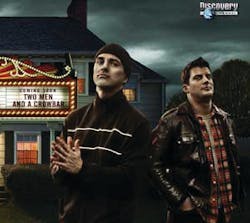Industry Insiders on the Real Importance of 'It Takes a Thief'
Ask folks like Assa Abloy's Frank Santamorena or Honeywell's Rich Simonetti and Ralph Maniscalco why they got involved in The Discovery Channel's "It Takes a Thief" television program, and they'll gladly tell you that it wasn't about the money. It wasn't even about the exposure. It was, as they all three have said, a very personal experience about the soft side of security. It was about connecting to people on a personal level with the trust it takes to secure their families and their homes.
Or, as Frank Santamorena, who became the show's lead security consultant, might tell you, "My wife said to me, 'You have to do this.'"
All three were involved with the production of the hit show that takes break-ins to a whole new level. Santamorena provided the gritty details the show needed to effectively secure the families' homes, while Simonetti and Maniscalco worked together and with others at Honeywell behind the scenes to donate alarm systems technology to keep the show running. It's often their panels, sensors, glass breaks, keypads and door position sensors that are being installed behind the scenes in the "It Takes a Thief" homes.
In an interview with SecurityInfoWatch.com and Security Dealer, Santamorena explained his driving duties behind the show in a language that all dealers and integrators can understand:
"You take the family and you look and see if there's good lighting at the home; you check the height of bushes, and you make sure that they're paying attention to the simple changes," he said when asked about how he started to secure these homes. "And when I sell them on security, I'm not afraid to ask them how valuable their family's safety really is. The mindset for residential alarm systems can't just be about personal property; it has to be about life safety."
Honeywell's Rich Simonetti said he understands exactly what that soft side of security means.
"I remember when my own home was burglarized," said Simonetti. "It was a frightening experience. My wife was terrified and said we needed to move. Shortly thereafter, I moved into the security industry. And from that day on, I have been very passionate about the service we provide."
Of course, to respond to the burglary Simonetti implemented some changes just like what the "It Takes a Thief" program would endorse. He changed the locks and installed an alarm system and assessed his property.
But rather than wait for a burglary to hit home, "It Takes a Thief" stages a burglary as a way to aptly point out security deficiencies at the guest family's residence. The break-ins are real. The glass is really broken; possessions are often trashed; privacy is truly trampled.
"What the show does," said Simonetti, "is to shock them through the theatrics, and it shows them that their family and personal possessions are dear to them. It teaches them that 'I should wake up!'"
That wake-up call is what's vital to the show, explained Maniscalco.
"The show encourages a preemptive approach effort, because it encourages proactive usage of security," he said. "I think the show was designed to show how much we could do."
But it's not just about showing what our technology can do, added Simonetti, but about showing the owners what they should be doing.
"You need to give homeowners things they can do -- to trim the bushes, to check on the paper's delivery," he explained. "We always provide those kinds of materials to the homeowners. It's not just about products, but about effecting change within behaviors."
And if you watch the show, you know that the behaviors do need to change. Ask Santamorena what he thinks the typical American homeowner's level of security is and Frank won't paint you a pretty picture.
"It's ridiculous; it's just dismal," he says. "Half the time I design security systems, it's after they've been broken into."
Prices are starting to change that mindset, notes Simonetti, especially as good technology becomes available at prices that are a bargain.
"The cost has dropped so that you can sell security before an incident ever happens," said Simonetti. "Years ago, it was always after the fact. Now people are buying it before because they can justify the price. And better sensors technology means that people can often use less equipment than they would have had to before."
The show, while it has been a great PR event for the entire security industry, was really about education, explained Santamorena.
"Even the producers learned a lot about security in the six months we were shooting. Sometimes they even learned too much," he joked, "and then they thought they knew what was best for the home. But really, they got very proficient. Everyone learned so much that all of a sudden they weren't just making a TV show -- they were providing a public service; they're saving people's homes."
"It's about the family," Santamorena continued. "It's about how we were able to change how they feel about their families and their lives. It's really an educational program, or else I wouldn't be part of it."
And that, we might all agree, is the best take-away from the entire season.
Steal Some Info...
- Coming soon: "It Takes a Thief" will start its second season on Sept. 12, 5 p.m. ET/PT. Don't miss it.
- Selling out? Well, not exactly selling out, but going commercial. Santamorena has hinted that at least one commercial establishment will be hit by the thieves during the second season. We can't wait.
- What channel? It's not on your local TV stations, so flip over to the Discovery Channel, where shows are not just about safaris any more.
- Coming to a town near you? Not likely, unless you live in the tri-state area around New York City.
